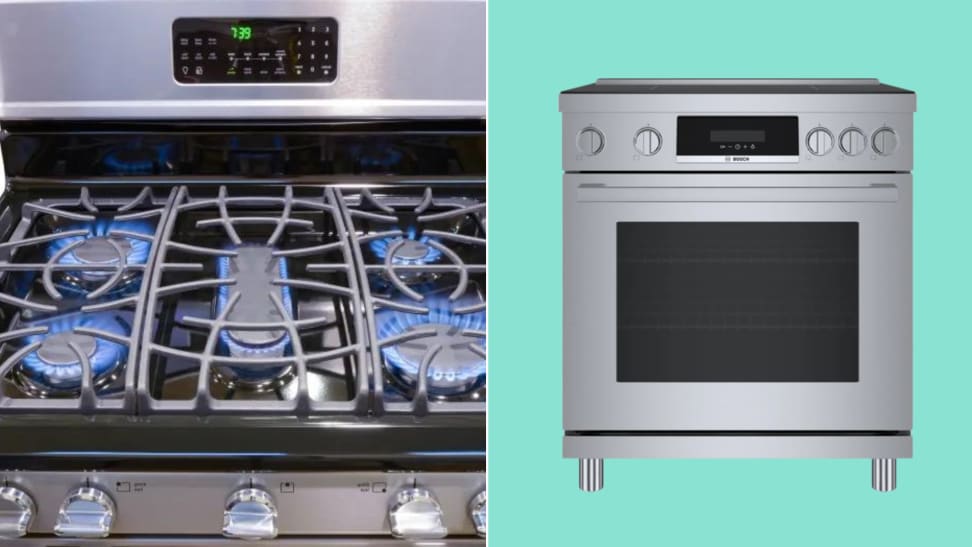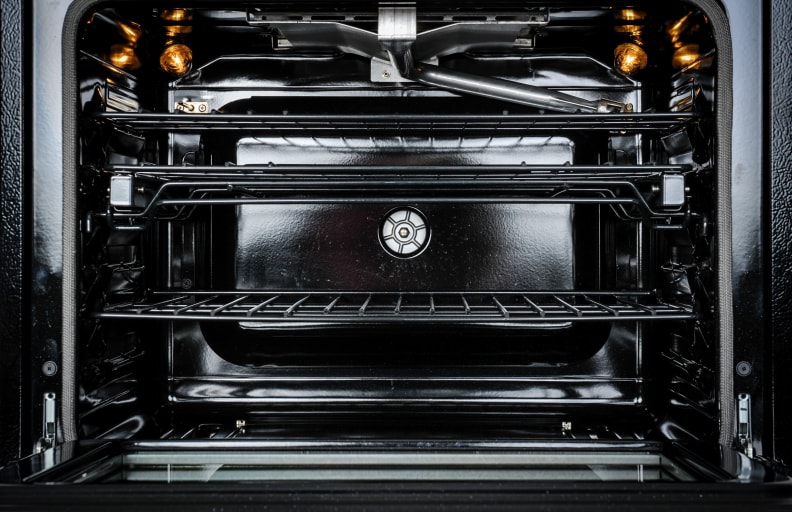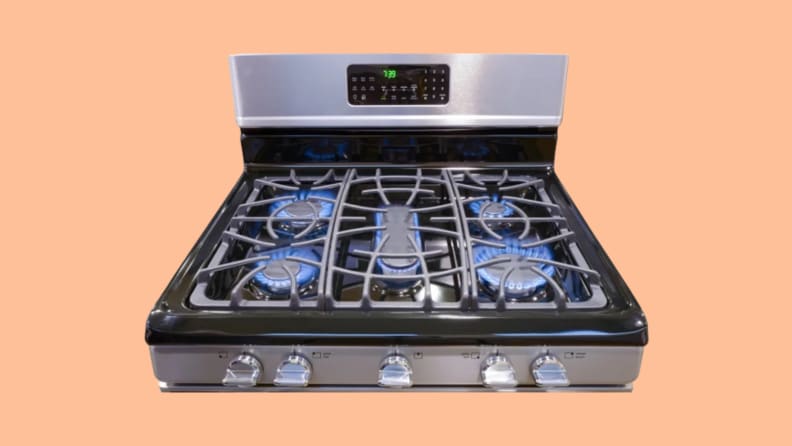Which type of range cooks best, gas or electric?
Everything you need to know about how your oven heats.
 Credit:
Reviewed / Bosch
Credit:
Reviewed / Bosch
Products are chosen independently by our editors. Purchases made through our links may earn us a commission.
It’s time someone lays out three important truths about the dilemma of cooking with gas vs. electric stoves:
Cooking with gas is powerfully fun for those who love it.
Cooking with gas is less efficient, and poses more health risks.
Induction is the future of cooking.
There is a fourth truth, but it’s less interesting than the above, and that’s the fact that many people don’t have an immediate choice of what powers their stove. It’s either gas or electric, and switching between the two can be quite difficult and costly. Therefore, when replacing a range, most people stick with what they’ve already got, even if they don’t love it (for cooking or environmental reasons).
For those who do have a choice, whether you’re renovating or building new, there’s a lot of controversy these days over what to pick. In some places, natural gas is banned in new construction.
Many pro chefs and ardent cooks still seem to favor gas ranges, while bakers gravitate toward electric ovens. And just about everyone is singing the praises of induction now. When you translate all of this to your home kitchen, what are the true pros and cons of gas vs. electric cooking?
Gas vs. electric cooktops and rangetops
The differences between gas and electric heat may seem obvious when you think about an open flame vs. an electric coil or smooth electric surface. However, the pros and cons behind each can be far less apparent.
Heat control
Of course, it’s easier to see the level of heat produced by gas, and when you change the heat level the payoff is instantaneous. Traditional electric elements take much longer to heat up and cool down, often requiring some careful watching and tricky maneuvers to avoid scorching delicate sauces, eggs, or anything you don’t want overcooked.
Gas heat may be more responsive, but it’s also less efficient in conducting heat to your food, since a higher percentage of the heat actually dissipates in the process, while electric cooktops offer better thermal contact between cookware and the heat source.
Induction ranges address these concerns with the electromagnetic connection that speeds heating exponentially—induction elements boil water almost twice as quickly as gas and standard electric cooktops. Since the cookware itself becomes the heat source, induction ranges offer greater incremental heat control without waiting for an external element to heat or cool.
When it comes to incremental heat control, induction generally offers a wide range of very precise temperature options, as well the reliability of repeatedly selecting the exact temperature you need. While you may be able to develop that repetitive exactness with a gas stove over many years of use, there’s always room for user error.
Heat transfer efficiency
In our testing, we’ve found that electric elements are usually able to reach higher high temperatures and lower low temperatures than gas burners. The reason? Again, this has to do (in part) with efficiency.
Reviewed’s chief scientist Dave Ellerby explains, “There's a more direct thermal contact between an electric element and cookware than a gas flame and cookware, so the heat transfer efficiency of electric stoves is higher. It's better still for induction stoves because the energy is transferred straight into the cookware.”
That makes the efficiency very high for induction compared to standard electric elements. With a gas burner, the pot sits on grates with a gap of air separating it from the flames and reducing the heat transfer, and thereby the efficiency.
In our range testing, we measure higher peak temperatures from electric than gas burners, 620°F on average versus 500°F.” While that sounds impressive, Ellerby also notes “The downside to higher peak temperatures is potential damage to cookware.”
Conversely, gas burners generally don’t go as low as electric versions due to the constancy of a gas flame versus the cycling on and off of the electrical element, which can produce a lower average temperature.
Ellerby points out, “We're reporting average temperatures across all burners, so a gas stovetop with a low BTU simmer burner could still give you good low-end temperature control for that burner.”
A note about cookware: It’s important that it’s properly sized. If gas flames uselessly lick the sides of the pan instead of hitting the bottom, a lot of the heat that’s generated is lost to the air and not used to actually heat food.
The same is true for induction where contact with the energy source creates the heat, so, for example, an oversized pan on a smaller burner won’t heat where there’s no contact with the magnets below.
Which heat source is best for ovens: Gas vs. electric?

Electric ovens have a slight advantage over gas when it comes to evenness.
Electric ovens retain heat better than gas ovens for one simple reason, gas can't burn without air. Gas ovens require an air intake, which means in order to create heat they also need to pull in cooler air from their surroundings. Electric ovens don't need to do that, so they retain more heat since they can be well sealed.
Temperature variation and relative humidity
Gas ovens have the advantage when it comes to preheating speed, but after that the temperature can fluctuate more than in an electric oven. All ovens generally need to cycle on and off in order to maintain a consistent temperature within the oven. However, due to the venting requirements of gas, and the on/off nature of the flame, the variation in temperature can be more dramatic than in an electric oven.
Gas ovens can provide a moister heat since combustion creates some humidity. This may be more beneficial to a roast than a cake or cookies, however it’s unlikely you’d notice a drastic difference in a home oven no matter what you’re cooking.
Dual fuel is still an option, for now
For those who truly love gas-stove cooking but want to reduce gas usage, dual-fuel ranges pair an electric oven with a gas cooktop. It's an ideal setup if you love the fine-grained control of gas burners up top, but want the superior baking prowess of electric in the oven.
There are even some ranges that offer gas and induction elements on the same cooktop. Some premium brands offer the ability to customize the type of burners you'd like on one range.
While these ranges wouldn’t be allowed anywhere that gas is banned, they’re an option for people who are not in one of those locations and looking to upgrade without sacrificing a gas stove.
Precautions are key for cooking with gas

Gas rangetops have their pros, but the cons require serious consideration.
If you currently have a gas stove, or can’t imagine giving it up, there are some important precautions to take to improve indoor air quality and protect the health of everyone in your home.
It’s never been a secret that gas appliances can give off fumes in the cooking process, and even when they are off. The impacts on climate change are widely known. However, many studies have come out in the past decade highlighting just how harmful those fumes can be indoors, especially for children.
An article published by Harvard Medical School underscores those health concerns and details steps to take to mitigate the effects of gas in the home. Chief among these precautions is proper ventilation, whether through a hood vent that vents to the outside, or by opening a window while cooking.
That will help during cooking, but an air purifier can also help with any particles released while the stove is idle. While it’s recommended to replace a gas stove with an electric, and ideally induction, option the next time you switch appliances, an air purifier is a lesser expense that can be implemented anytime.


